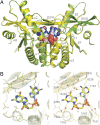Molecular basis for the specific recognition of the metazoan cyclic GMP-AMP by the innate immune adaptor protein STING
- PMID: 26150511
- PMCID: PMC4517257
- DOI: 10.1073/pnas.1507317112
Molecular basis for the specific recognition of the metazoan cyclic GMP-AMP by the innate immune adaptor protein STING
Abstract
Cyclic GMP-AMP containing a unique combination of mixed phosphodiester linkages (2'3'-cGAMP) is an endogenous second messenger molecule that activates the type-I IFN pathway upon binding to the homodimer of the adaptor protein STING on the surface of endoplasmic reticulum membrane. However, the preferential binding of the asymmetric ligand 2'3'-cGAMP to the symmetric dimer of STING represents a physicochemical enigma. Here we show that 2'3'-cGAMP, but not its linkage isomers, adopts an organized free-ligand conformation that resembles the STING-bound conformation and pays low entropy and enthalpy costs in converting into the active conformation. Our results demonstrate that analyses of free-ligand conformations can be as important as analyses of protein conformations in understanding protein-ligand interactions.
Keywords: STING; cGAMP; ligand conformation; phosphodiester linkage.
Conflict of interest statement
The authors declare no conflict of interest.
Figures







Similar articles
-
Crystal structures of porcine STINGCBD-CDN complexes reveal the mechanism of ligand recognition and discrimination of STING proteins.J Biol Chem. 2019 Jul 26;294(30):11420-11432. doi: 10.1074/jbc.RA119.007367. Epub 2019 Jun 5. J Biol Chem. 2019. PMID: 31167783 Free PMC article.
-
Cyclic GMP-AMP containing mixed phosphodiester linkages is an endogenous high-affinity ligand for STING.Mol Cell. 2013 Jul 25;51(2):226-35. doi: 10.1016/j.molcel.2013.05.022. Epub 2013 Jun 6. Mol Cell. 2013. PMID: 23747010 Free PMC article.
-
Structure-function analysis of STING activation by c[G(2',5')pA(3',5')p] and targeting by antiviral DMXAA.Cell. 2013 Aug 15;154(4):748-62. doi: 10.1016/j.cell.2013.07.023. Epub 2013 Aug 1. Cell. 2013. PMID: 23910378 Free PMC article.
-
Cyclic GMP-AMP as an Endogenous Second Messenger in Innate Immune Signaling by Cytosolic DNA.Annu Rev Biochem. 2017 Jun 20;86:541-566. doi: 10.1146/annurev-biochem-061516-044813. Epub 2017 Apr 7. Annu Rev Biochem. 2017. PMID: 28399655 Review.
-
Second messenger 2'3'-cyclic GMP-AMP (2'3'-cGAMP): Synthesis, transmission, and degradation.Biochem Pharmacol. 2022 Apr;198:114934. doi: 10.1016/j.bcp.2022.114934. Epub 2022 Jan 31. Biochem Pharmacol. 2022. PMID: 35104477 Review.
Cited by
-
Current understanding of the cGAS-STING signaling pathway: Structure, regulatory mechanisms, and related diseases.Zool Res. 2023 Jan 18;44(1):183-218. doi: 10.24272/j.issn.2095-8137.2022.464. Zool Res. 2023. PMID: 36579404 Free PMC article. Review.
-
Viral and metazoan poxins are cGAMP-specific nucleases that restrict cGAS-STING signalling.Nature. 2019 Feb;566(7743):259-263. doi: 10.1038/s41586-019-0928-6. Epub 2019 Feb 6. Nature. 2019. PMID: 30728498 Free PMC article.
-
Tembusu Virus Nonstructural Protein 2B Antagonizes Type I Interferon Production by Targeting MAVS for Degradation.J Virol. 2022 Jul 27;96(14):e0081622. doi: 10.1128/jvi.00816-22. Epub 2022 Jul 11. J Virol. 2022. PMID: 35867574 Free PMC article.
-
Computational and NMR spectroscopy insights into the conformation of cyclic di-nucleotides.Sci Rep. 2017 Nov 29;7(1):16550. doi: 10.1038/s41598-017-16794-4. Sci Rep. 2017. PMID: 29185472 Free PMC article.
-
Regulation and function of the cGAS-STING pathway of cytosolic DNA sensing.Nat Immunol. 2016 Sep 20;17(10):1142-9. doi: 10.1038/ni.3558. Nat Immunol. 2016. PMID: 27648547 Review.
References
Publication types
MeSH terms
Substances
Associated data
- Actions
Grants and funding
LinkOut - more resources
Full Text Sources
Other Literature Sources
Molecular Biology Databases
Research Materials
Miscellaneous

